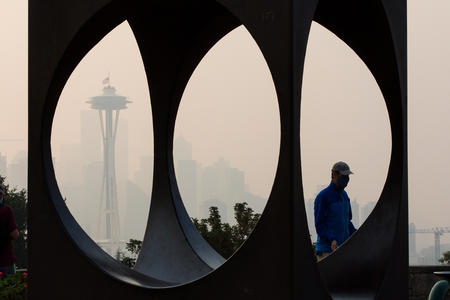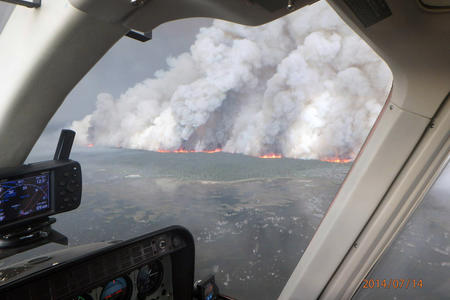All of this has required years of camping and climbing through rough terrains for weeks on end, often under a blanket of smoke. Three summers back, he spent a month in Idaho’s Selway Bitterroot Wilderness when fires in British Columbia, Washington and Oregon, made it “cloudy down to the ground.” N95 masks, recommended to help keep out tiny particles like those in wildfire smoke, were simply impractical during intense, huffing-and-puffing hikes required to monitor the landscape. And there was no respite at night, with Hessburg and his team camping amid smoke trapped in Idaho’s mountain valleys. They persevered, putting wet cloths over their mouths, making things a little more comfortable.
The next year, Hessburg went hiking with his daughter in Lake Chelan in Central Washington, an annual family tradition. “It was the first time I ever noticed that I had to stop and get some air as we were going along,” he says, estimating that his pace was halved.
Back home in Wenatchee, Hessburg, wondering what decades of smoke did to his lungs, looked up his symptoms. He read studies about wildfire smoke and respiratory health, and thought maybe he had chronic obstructive pulmonary disease (COPD) or asthma. He has tried to train his way back to health, but two years later he says he’s still not back to normal. He’s not sure he’ll ever be able to recover.
Ask us questions about your health and wildfire smoke at the bottom of this story, or click here.
“I used to think I was bulletproof,” he says. “Now I know I am not.”
Hessburg is now encouraging his children, who wanted to follow in their dad’s footsteps, not to pursue wildland firefighting. “As I’ve seen wildfire behavior over the decades get worse, I’ve become concerned about the nature of what my kids are exposed to,” Hessburg says. He suggested to his middle son, who wanted to be a career wildland firefighter, that he rethink the dream. After 11 years as a seasonal firefighter, he finally took his dad’s advice, deciding it’s simply not worth the risk.
For decades, researchers have studied occupational health risks for cancer among structural firefighters — those who douse burning buildings. They are regularly exposed to an array of chemicals: those baked into the protective clothing they wear and essential to the fire retardants that they use, and others emitted from the many materials that can light up, such as couches, TVs and Barbie Dolls. That makes them vulnerable to respiratory, digestive and urinary cancers, and twice as likely as the average American to get mesothelioma, an aggressive and rare cancer caused by asbestos exposure.
Two studies by the National Institute for Occupational Safety and Health concluded that firefighters face a 9% increase in cancer diagnoses and a 14% increase in cancer-related deaths, compared with the general population. More recent research suggests that leukemia is a concern, too. Research from the University of California Berkeley shows that some female firefighters may have an increased risk of breast cancer from their exposure to PFAS, “forever chemicals” used in firefighting foams and gear that can affect the immune system and have been linked to cancer.
InvestigateWest is a Seattle-based nonprofit newsroom producing journalism for the common good. Learn more and sign up to receive alerts about future stories here.
But there have been fewer studies on wildland firefighters, who battle an increasingly long and hostile fire seasons. The Centers for Disease Control and Prevention (CDC) says that from 2000 to 2019, 400 wildland firefighters died on the job, but this may hide slower, quieter illnesses and death.
The biggest problem is smoke. Microscopic particles from wildfires, called PM2.5, are bad for everyone, causing inflammation that can lead to serious respiratory and, to a lesser degree, heart problems. But as the rest of us are told to stay inside, close the windows and use a HEPA filter, wildland firefighters are running toward the smoke. They often have no respite. Firefighters regularly work 14-plus-hour days, and then camp near a fire for weeks on end.
Michelle Garcia worked fighting wildfires in Ventura, California, for nearly two years. At the time she was among the incarcerated firefighters who come from the state’s prisons and make $1 an hour fighting some of the state’s toughest wildfires. Many nights, she recalls, “we would just sleep on the mountain. We had no sleeping bags, no tents, just a space blanket that looks like a little bag of Doritos chips turned inside out.”
Only bandanas to protect them
As a result of the onslaught, the Occupational Health and Safety Administration says wildland firefighters are more likely than the general population to face long-term health effects from wildfire smoke, with risk increasing the more and longer a person is exposed. A 2019 risk assessment estimates that wildland firefighters have a significantly increased chance of lung cancer and heart disease. OSHA notes that wildland firefighters are also exposed to carbon monoxide, which at high levels can lead to death and with long-term exposure is linked to heart disease. They also inhale a lot of silica dust, which can cause cancer.
N95 masks can offer protection. But they’re impractical for firefighters, with the masks quickly wilting in the heat. Respirators, like those structural firefighters use, won’t work for wildland firefighters because they are heavy, can reduce visibility and offer breathing support for only a short period of time. Instead of donning full fire suits that structural firefighters have, wildland firefighters wear light, “hikeable” green pants and yellow shirts.
For breathing support, most rely on makeshift cloth masks, which can help keep out large debris but offer no protection from small, smoky particles. Garcia says the California Department of Corrections and Rehabilitation’s protective equipment consisted of a couple of bandanas, which she used either as a sweatband or a mask.
“I remember the smoke bothering me and I couldn’t breathe, and then another time my sunglasses melted on my face,” she says. “At first you’re like, ‘Whoa, look at this, we’re so badass.’ But I also thought, ‘This is kind of scary, this is dangerous!’ ”
It may be more so as wildland firefighters are increasingly exposed to some of the same materials structural firefighters have faced for years — burning cars, molten refrigerators, singed electronics — as wildfires engulf not only forests, but whole towns, too.
"It’s not just PM2.5 anymore, but also stuff that people build, so the effects become more insidious,” says Rich Elliot, deputy fire chief of Kittitas Valley Fire and Rescue, in Ellensburg. Last year, UC Berkeley released a study suggesting that firefighters working in the 2017 Tubbs Fire, one of the largest in California’s history, had elevated levels of mercury and other chemicals, including PFAS, in their blood.
The National Institute of Occupational Health and Safety, along with the U.S. Forest Service, is trying to learn more about wildland firefighters’ health risks. By monitoring air quality throughout firefighters’ shifts and collecting blood and urine samples, researchers are hoping to see what the job does to firefighters’ lungs, heart, kidneys and hearing.
One of the researchers, Kathleen Navarro, is trained as a wildland firefighter herself. She says simple changes to a workday could make a big difference. Last summer, while she worked on a prescribed burn, “the smoke got so bad because the wind shifted that I literally couldn’t see in front of me,” she recalls. Her job was make sure the fire didn’t jump the line, and since she couldn’t just up and leave and risk sparking a huge wildfire, she took shifts with a colleague so that they would share the burden of exposure. Navarro says nimble little decisions like these are key: “Every fire is different, every day is different, so it means those decisions have to be made constantly with an ever evolving situation and conditions.”
Sharing the burden, lowering the risk
Bigger changes could help, too. Because health risks increase the more a person is exposed, an overstretched firefighting force may also be a less healthy one. And America’s wildland firefighters are increasingly spread thin, as fire seasons become longer and more intense.
Countrywide, considering the part-time, seasonal, public, private and incarcerated workforces, there are about 33,000 people who can be deployed to fight forest fires. Some years, that’s enough. In other years — 2020, 2018, 2017, 2016, 2013 and 2010 — “we ran out of firefighters,” says Joe Stutler, the western region co-chair, Wildland Fire Cohesive Strategy, National Multi-Agency Coordinating Group. During particularly busy years, firefighters have been brought in from places like New Zealand, Australia and Mexico, in addition to a regular slew of Canadians.
Kittitas Valley Fire and Rescue's Elliot would prefer to have a larger number to pull from domestically, noting that bringing in firefighters from afar is a huge expense. But having an excess, sometimes idle workforce “goes against the entire premise of our economy, which is that you should be penalized for having extra stuff that doesn’t do anything,” observes Elliot. “We’ve seen the trouble with that idea with the small stockpile of PPE in the country for coronavirus. The same thing is true about firefighting resources.”
Not having enough firefighters during a busy fire season can provoke a vicious cycle. More acres burn, which pushes up the cost of a suppressing fires. That then leaves little funding for preventive activities such as prescribed burns and thinning underbrush that has grown unnaturally thick over a century of misguided firefighting policies.
“And then the next year, you have more wildfires,” says Elliot.
While some states are hiring more firefighters — California recently announced it would have additional 1,000 — other efforts are slowing down, with all three of Washington’s Wildland Fire Training Academies closed this summer due to the coronavirus.
Despite the need for a robust workforce, significant roadblocks prevent thousands of formerly incarcerated firefighters like Garcia from being hired once they’re out of prison. Because they were convicted of felonies, all of the women Garcia fought fires with weren’t eligible to be hired, despite sometimes having years of work under their belts.
“These were the best of the best, the cream of the crop, who could never get jobs in the field,” Garcia said. That’s starting to change. Garcia now works with a new program that allows male parolees to enroll in an 18-month-long fire training program, with graduates eligible to be hired by CalFire. And earlier this month California Gov. Gavin Newsom signed a bill to allow inmate firefighters to have their records cleared, paving the way for them to be eligible for firefighting jobs after they are released.
In Washington, former felons are eligible for hiring at the state Department of Natural Resources.
“DNR has hired people who were previously in the Correctional Camps Program,” said Stevie Mathieu, spokesperson for the agency,” some of whom continue to work for DNR and I’m told are doing great."
More firefighters may be needed now more than ever, given the double whammy of the country’s worst fire season on record and the coronavirus pandemic. Because people with damaged lungs are more susceptible to severe illness, crew managers are trying to give wildland firefighters more breaks between shifts so that their bodies can rest and recover. Instead of two days off, the goal is to give them three or four. Some crews also have clean air trailers for sleeping and rest so that firefighters “can chew smoke a little bit less,” says Stutler. “If you started your season from June and it’s September, and you’ve had a steady diet of smoke, your respiratory capacity is going to be way down,” he says.
Giving firefighters more time off could help protect them from COVID-19, and potentially from longer-term health impacts, too. Stutler is hopeful that trying these new ideas out during the worst of times can pave the way for sustained changes, although he notes they’re expensive, with the overall fire suppression costs expected to increase 25% to 40% this year, he says. “My hunch is that the silver lining of the pandemic will be to assess and improve the overall health conditions at a fire camp,” says Stutler. “But the reality is, we’re building a bridge as we walk on it.”
Levi Pulkkinen contributed reporting to this story.






